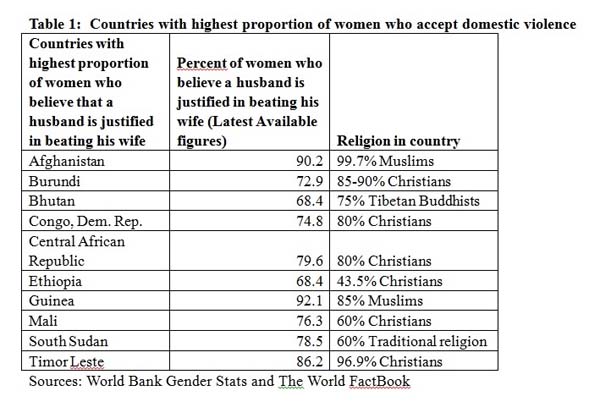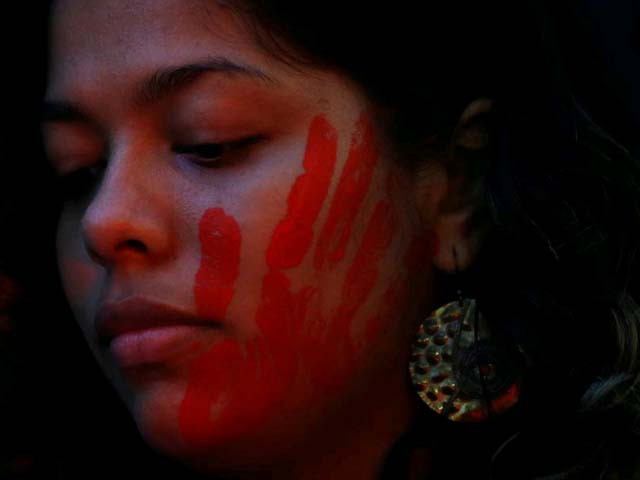For me, before being acquainted with data on countries where such beliefs persist, it was unimaginable that some women think domestic violence is acceptable. I think most readers would be surprised to know that wife beating, the most common form of domestic violence, is not just a norm in most countries, but also found acceptable by the victims.
Most recently, a tempestuous social and media brouhaha prompted a proposal from the religious council in Pakistan that sought to legalise wife beating. The proposal that husbands be allowed to “lightly beat” their wives was immediately derided and rebuked in almost every major circle.
In a country where as many as 70%-90% of women have been inflicted with some form of violence or abuse, the proposal to ignite, rather than quench domestic violence, is utterly despicable.
Hypothetically, let’s forget the gender issue for a while.
If almost all the members of a certain faction are suffering from afflictions and violence, it is the duty of religious scholars to address it and not sell them on the altar of their personal interests. To the proponents of the ‘wife-beating act,’ I have only one question; would you be able to sleep at night knowing that your daughter is being subjected to some form of violence at that very moment? Since we are made of flesh and blood, how can we not wince at even the slightest innuendo of violence toward our loved ones?
In 2015, Pakistan saw two landmark improvements towards eradicating domestic violence; the passing of the law criminalising domestic violence and the Punjab Protection of Women Against Violence Act 2015. However, Pakistan’s exacerbating performance on the gender parity front stipulates more than just laws to address the plight of women.
According to the Global Gender Gap report 2014 by the World Economic Forum, Pakistan is the second worst country in terms of gender equality. In 2013, 56 women were murdered and their only fault was that they gave birth to girls. According to the Thomas Reuters Foundation Poll, Pakistan is the third most dangerous country in the world for a woman. Afghanistan tops that list while India ranks fourth.
In a country marked by early marriages, where more than half the girls (nearly 53%) between the ages of 15-19 believe that domestic violence is justified, the political right insinuating that “Pakistani women are out of control” and that the “misery of husbands” should be alleviated by giving them a legal baton, lampoons the plight of women.
Interestingly, even though major media echelons picked up a story on the 53% of Pakistan teenage girls accepting domestic violence, none of them bothered to delve deeper into the demographics of such beliefs. The New York Times, for instance, did a piece on it, avoiding any details on the demographics that could divulge the root causes of such beliefs. Hence, most critics don’t shy away from jumping to the conclusion that women in Islamic countries only adhere to these beliefs.
I will briefly touch upon the aforementioned notion to address that the concept of wife beating doesn’t persist in a homogeneous fashion across countries when it comes to religion. I would also argue that these beliefs are more likely a result of being deprived of an education and/or poverty instead of religion. This deprivation is what I would term as the ‘twilight zone’ referring to women in areas where the light of education has not reached and where abjection of poverty has depleted the vigour and motivation needed for resistance.
This submission breeds the status quo instead of challenging it. As for beliefs shared in a homogeneous fashion with respect to religious concentration, the findings are rather surprising. In countries where a high proportion of women accept wife beating, religious beliefs (Christians, Buddhist and Muslims) play a pivotal role.
Ninety two per cent of women in Guinea believe that a husband is justified in beating his wife for any of the following reasons:
- When she argues with him
- When she burns the food
- When she goes out without telling him
- When she neglects the children
- When she refuses to have sex with him
Of the figures available through World Bank Gender Stats, Afghanistan ranks second with 90% of its women believing that wife beating is justified.
Table 1 shows a list of countries with the highest proportion of women (countries with nearly 70% or higher) who share these beliefs with respect to religious concentration in each country.

Table 1 clearly negates the myth that acceptance of domestic violence persists in a homogenous fashion with respect to religion.
Are these beliefs set in stone? The answer to that question is no. In Burkina Faso, the proportion of women who shared those beliefs was 71% in 2003 which dwindled significantly to 43% by 2010 – a 39% reduction in seven years. In Sierra Leone this proportion shrank from a hefty 85% in 2005 to 62% in 2013.
On the other hand, there are a number of countries where this proportion seems to be on a rise.
In Cambodia, for example, merely 13.8% of women were reported to share those beliefs in 2005 which more than quadrupled to 50% by 2014. In Madagascar, this percentage rose from 28% in 2004 to 45% in 2013. Kazakhstan, Indonesia and Peru exhibited a rise in the proportion of women who consider that wife beating is justified.
So what do the women of twilight zone look like?
In Cambodia, a typical woman who thinks wife beating is justified (53%) is a rural aged woman (around 58% of women who share these beliefs are aged 40-years or above compared to the 46 % of women aged 15-19 years), is employed (for cash or no cash, married, has five or more children, bears no education (58 % of women with no education share these beliefs compared to 40 % of women with secondary or higher education) and falls into the lowest wealth quintile (58% of women in the lowest wealth quintile accept wife beating as compared to 37% in the highest wealth quintile).
In Pakistan, 42% of women consider wife beating acceptable. 50% of those are rural women and 57% fall into poorest quintile of wealth. These beliefs dilute with improvement in the economic status: dwindling to 48% in the middle quintile and 16% in the richest quintile.
In India, 47% of women consider that a husband is justified in beating his wife and 52% of these women are from rural backgrounds. With respect to economic status, surprisingly, this percentage is not the highest in the poorest quintile; rather, it is highest in second, middle and fourth quintiles. Of the richest quintile, 30% accept wife beating.
With respect to Pakistan, 88% of the rural women are illiterate. This situation is most critical in Balochistan and Khyber-Pakhtunkhwa where the percentage of illiterate women touches 84% and 65% respectively. Given this abysmal depth of the twilight zone in Pakistan, the whopping figure of 53% of teenage girls accepting domestic violence should not come as a surprise.
The reasons why we need to care about the high proportion of women accepting domestic violence are two-fold: one, that acceptance of violence by women breeds more violence against women; second, women’s compliance with violence undermines women’s motivation to stand for their rights.
In one of my recent studies (a work in progress), I carried out a cross-sectional analysis of 83 countries, for which the data was available, to see if a correlation exists between acceptance of domestic violence by women and the maternal morality ratio. Surprisingly, the correlation coefficient turns out to be a positive 0.63 which means that maternal mortality ratio is high in countries where a large portion of women accept domestic violence. Secondly, the correlation between women’s acceptance of violence and female literacy is -0.79 which means the higher the acceptance of domestic violence by women is, the lower the female literacy rate.
In sum, the purpose of this exercise is to argue that there exists only one weapon that can extirpate negative social norms and cultural stereotypes: education. It also makes a case for developing countries like Pakistan to raise their education expenditure. Pakistan currently spends merely 2% of its GDP on education. The average percentage of education expenditure in GDP is 4% even for heavily indebted poor countries. Pakistan not only missed the UN target of 58% literacy rate but ended up with a sliding literacy rate-the literacy rate declined by 2% in 2013-2014, according to Pakistan Economic Survey 2014-2015.
Amid these woes, efforts to reach out to the women in twilight zone need to be expedited if we are to save them from being murdered or being subjugated to violence: the light of education must reach the twilight zone at all cost.



COMMENTS
Comments are moderated and generally will be posted if they are on-topic and not abusive.
For more information, please see our Comments FAQ